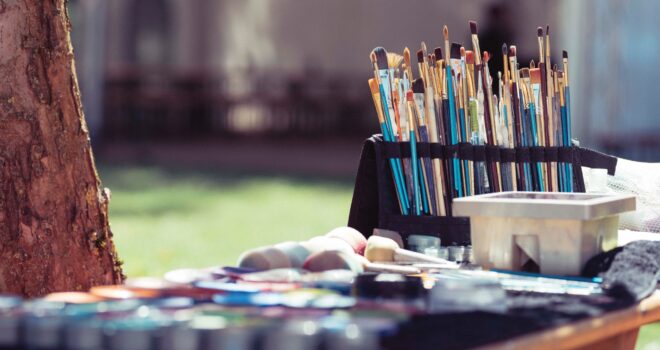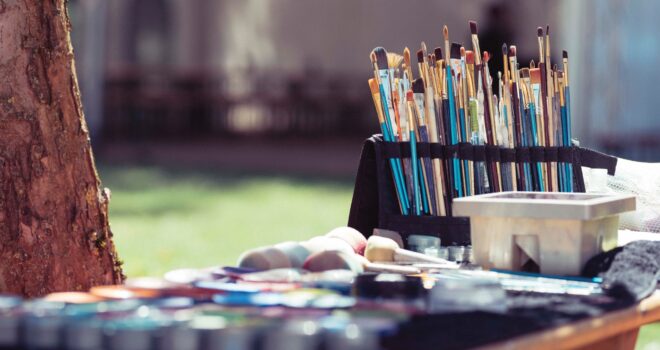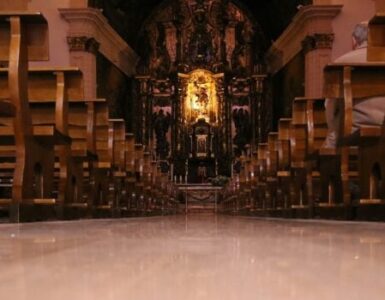A few years ago I took up painting as a hobby. I don’t know about you, but when I find a hobby I really enjoy, I tend to go a little overboard in acquiring all the associated paraphernalia. I started out with a small set of student grade watercolors my wife purchased for me, but quickly decided I needed an upgrade. Watercolor paints typically come in either tubes or pans. The set my wife gave me was pans, so I bought another set of student grade paints in tubes to give that a try. Around the same time I purchased a set of professional grade watercolor pans with thirty-six different colors, which quickly became my go-to. But that didn’t stop me from purchasing even more paint over the years from different manufacturers. Art stores have sales all the time and it’s hard to pass up a bargain.
One day I noticed that of the abundant rainbow of colors in my palette, there were just a few I was starting to run low on. Without intending to, I was gravitating toward certain colors in my work, while there were other colors I never used at all. At some point I learned that many advanced artists prefer to work from limited palettes. A common set-up is what’s called a split primary palette. This consists of only six colors, a cool and a warm hue each of red, blue and yellow. By mixing these basic ingredients the artist can create a full spectrum.
At the same time that I was stocking up on paints, I was also accumulating a variety of brushes. And as with my paints, I noticed a similar narrowing phenomena occurring. Despite the wide range of paint brushes available to me, I was reaching for the same one or two 90% of the time. These were my trusted workhorses. I knew how to use them and how they would perform. Their familiarity in my hand made it easier for me to enter into the process of painting.
When I went on pilgrimage to the Holy Land earlier this year, I wanted to take along a small travel watercolor journal to document the places I visited. I was determined to pack as lightly as I could, so I kept my artist’s kit to a minimum: a pencil, a pen, a travel brush, and a small travel palette with only six colors of paint. For ten days in the Holy Land, I spent the evenings in my hotel room documenting my memories of that day from only these limited shades. Not once did I find myself wishing for a color I didn’t have.
Since returning from that pilgrimage, I have continued the practice of working with fewer colors because I find it makes me a better artist. It frees me from having to make so many choices before I even begin and allows me to focus more on the actual process of painting. And because I am working from a more narrow color range, the work I produce looks more coherent and integrated with itself. In other words, not only do I enjoy the process more; I also get better results.
It strikes me that a similar truth can be said about prayer. One of the things I love about Catholicism is its treasure trove of devotional practices. Over two millennia, the Church has developed a rich tapestry of prayer traditions that can be overwhelming to a neophyte. Like walking into a well-stocked art shop, one can be almost paralyzed by the options.
There is, of course, the quintessential rosary. Then one discovers the Divine Mercy chaplet and learns that it is possible to say other prayers on those beads. That opens up a whole world of different chaplets. There is the Liturgy of the Hours (the official prayer of the Church). There are the Stations of the Cross (not just for Lent). There is lectio divina and Eucharistic Adoration. There are countless novenas and litanies, a plethora of penances and devotions to every saint in heaven. To open a Catholic prayer book is to open yourself up to a whole world of piety, and it can be easy to feel lost. Do you observe the First Friday and Saturday devotions? Pray the Angelus? The Little Office of the Blessed Virgin Mary? Have you consecrated yourself to the Sacred Heart? To the Immaculate Virgin? Do you wear the Brown Scapular? Are you missing out on something essential if you don’t?
All of these devotions are good aids to growing in holiness. But it doesn’t follow that to be holy everyone must practice all of them. To attempt to do so would not only be difficult, but harmful to our prayer life. To return to our painting metaphor, if I felt compelled to use every available color every time I painted, my work would be a mess. With prayer, as with art, working from a “limited palette” often yields better results.
By choosing to focus on just a few devotional practices, you allow yourself to enter more fully into what those devotions have to offer. You’ll likely find the process of prayer more restful and the end results more rich. The monastic orders figured this out long ago. The spiritual masters we find in religious life didn’t get there by practicing every form of prayer, but by immersing themselves deeply into one particular prayer tradition. Lay men and women may not be bound to a particular rule of prayer, but that doesn’t mean everyone can’t benefit from a more focused prayer life.
In the Introduction to the Devout Life, St. Francis de Sales recommends many good devotional practices for the layperson. But at the end of that book, he cautions: “If it were needful to perform all these exercises every day, undoubtedly they would wholly engross us, but they are required only at certain times and places, according to our circumstances.” The goal is to grow in holiness, not to accumulate devotions. Devotions are a means to an end. The trick is to carefully select those means that will best help us achieve that end, just as an artist chooses the particular colors he needs for his work. More than that would only muddy the picture.
One final note: despite what I have written in praise of a limited palette, I don’t regret acquiring all the art supplies I have any more than I regret the various forms of prayer I have picked up and laid down over the years. In both cases, trying different options led me to discover what worked best for me. Since we each come to God with different temperaments and needs, it’s normal to find some devotions more beneficial than others. It may take some trial and error to determine what works best, and indeed that may change over time.
Nor do I plan to discard all my lesser used supplies! Pulling out an under-used palette from time to time helps to keep things fresh and can often be inspiring. The same can be true in prayer. If your daily rosary has grown a bit stale, praying the Divine Mercy chaplet for a week instead may allow you to return to the rosary with renewed appreciation. Lectio divina may not be your “go-to” method of prayer, but devoting a month to meditating on a passage from the Gospel of John every morning may yield fruit you never expected.
Like the colors of an artist’s palette, prayer comes in many hues and shades. The key to making art, instead of a mess, is to master a few favorites and use them to create something beautiful.
Photo by Kai Oberhäuser on Unsplash












